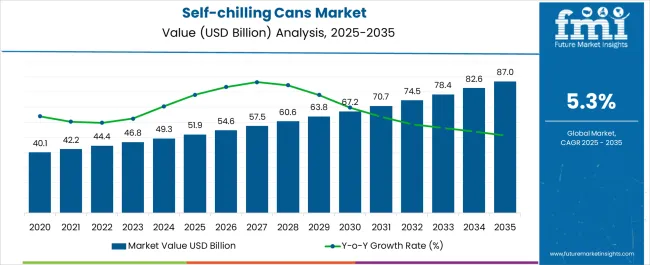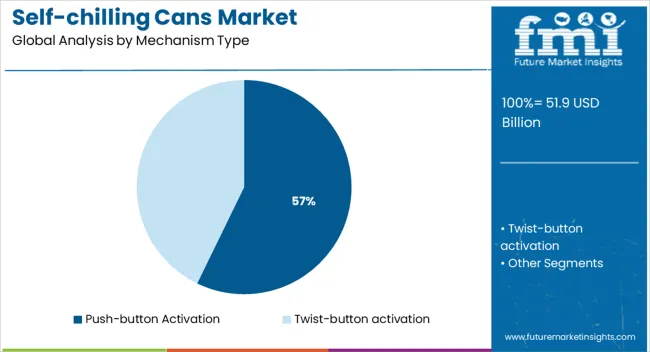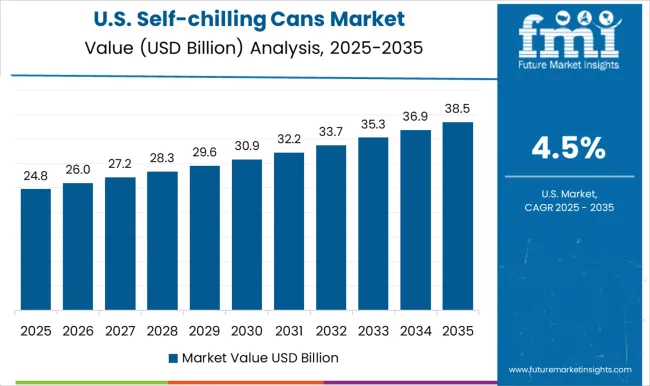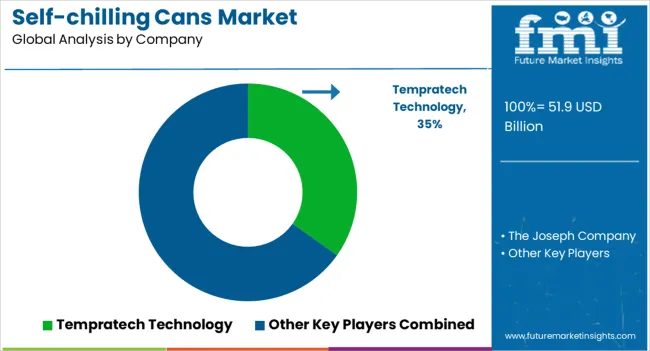The Self-chilling Cans Market is estimated to be valued at USD 51.9 billion in 2025 and is projected to reach USD 87.0 billion by 2035, registering a compound annual growth rate (CAGR) of 5.3% over the forecast period.

| Metric | Value |
|---|---|
| Self-chilling Cans Market Estimated Value in (2025 E) | USD 51.9 billion |
| Self-chilling Cans Market Forecast Value in (2035 F) | USD 87.0 billion |
| Forecast CAGR (2025 to 2035) | 5.3% |
The self chilling cans market is experiencing robust momentum as consumer preference shifts toward convenience, portability, and enhanced on the go beverage experiences. Rising demand for packaging innovations that eliminate the need for external refrigeration is propelling adoption across both premium and mass market beverage segments.
Advances in thermal engineering and safe refrigerant materials have made these cans more efficient, lightweight, and compliant with sustainability standards. Beverage manufacturers are increasingly adopting self chilling cans to differentiate products, enhance brand visibility, and cater to outdoor consumption scenarios.
Regulatory focus on eco friendly packaging solutions and consumer expectations for instant beverage cooling are further reinforcing adoption. The market outlook remains favorable with opportunities expanding across both alcoholic and non alcoholic categories as brands emphasize user convenience and product innovation.
The market is segmented by Mechanism Type, Capacity Type, and Application Type and region. By Mechanism Type, the market is divided into Push-button Activation and Twist-button activation. In terms of Capacity Type, the market is classified into Up to 4 Oz, 4-16 Oz, and Above 16 Oz. Based on Application Type, the market is segmented into Alcoholic Beverages and Non-Alcoholic Beverages. Regionally, the market is classified into North America, Latin America, Western Europe, Eastern Europe, Balkan & Baltic Countries, Russia & Belarus, Central Asia, East Asia, South Asia & Pacific, and the Middle East & Africa.
The push button activation segment is expected to contribute 57.20% of total revenue by 2025 within the mechanism type category, making it the leading segment. Growth has been supported by its user friendly design, rapid cooling capabilities, and reliable performance, which enhances consumer convenience during outdoor and travel consumption.
Push button systems require minimal effort to activate, offering instant chilling without external equipment. Continuous improvements in energy efficiency and environmentally safe refrigerants have further increased acceptance.
As beverage companies prioritize consumer centric innovations, this mechanism type has secured dominance due to its blend of simplicity, efficiency, and scalability.
The push button activation segment is expected to contribute 57.20% of total revenue by 2025 within the mechanism type category, making it the leading segment. Growth has been supported by its user friendly design, rapid cooling capabilities, and reliable performance, which enhances consumer convenience during outdoor and travel consumption.
Push button systems require minimal effort to activate, offering instant chilling without external equipment. Continuous improvements in energy efficiency and environmentally safe refrigerants have further increased acceptance.
As beverage companies prioritize consumer centric innovations, this mechanism type has secured dominance due to its blend of simplicity, efficiency, and scalability.

The push button activation segment is expected to contribute 57.20% of total revenue by 2025 within the mechanism type category, making it the leading segment. Growth has been supported by its user friendly design, rapid cooling capabilities, and reliable performance, which enhances consumer convenience during outdoor and travel consumption.
Push button systems require minimal effort to activate, offering instant chilling without external equipment. Continuous improvements in energy efficiency and environmentally safe refrigerants have further increased acceptance.
As beverage companies prioritize consumer centric innovations, this mechanism type has secured dominance due to its blend of simplicity, efficiency, and scalability.
The self-chilling can market is witnessed a CAGR of 4.7% during the historic period with a market value of USD 40.1 Million in 2020 to USD 44.7 Million in 2025.
The self-chilling cans are ingenious beverage packaging solutions, with the ability to maintain the temperatures below a pre-fixed range, cans are stored at ambient temperature, the self-chilling can, with its ability to cool the drink into various temperature, gives the consumer the ability to enjoy their drinks at the state they want. The product is designed to provide instant, portable, safe, long-lasting thermal technology.
The self-chilling can have been tested by the EPA (Environmental Protection Agency) regarding its harm to the environment after the self-chilling can disposal found that it contains eco-friendly reclaimed CO2 in HEU and the self-chilling cans are 100% Recyclable. And self-chilling cans are advanced designs that utilize the latest breakthrough in thermal, insulating, and vacuum heat pump technology.
The market of self-chilling cans is expanding, Can’s™ innovative design is 100% safe, the self-contain I.C. can Can’s™ uses no carbon dioxide or any other compressed gas, over 70 years the beverage industry try to develop technology that safely embedded inside beverage can container order deliver to a ‘chill on demand’ beverage, consumers in the area with a limited refrigeration, participants in activities such as a camping, boating, etc.
Self-chilling can is a new technology and it provides cool products on demand, cause the cooling effect regulated over endothermic desorption of carbon dioxide previously absorbed in activated carbon and acquire the potential to be applied to any type of product that needs to be cooled to, Proprietary engineering creates a temperature drop proven to reduce the I.C. Can’s™ contents by a 30° Fahrenheit(16.7°C) in just three minutes. no refrigeration or ice is required to enjoy a cold-drinks.
Cold refreshing drinks makes consumer satisfied and feel as if their thirst for drink quenched forever, due to the consumer having ever busy-lives, consumer finds themselves buying multiple energy drinks Because they are not able to keep their drink chilled while move one place to another place, consumers of drink, such as long-distance drivers, are normally left frustrated when their energy drinks warm in socially during summer, the can have an outer steel casing, which make is acts as an insulator and cushioning the drink form acquiring heat. The inner side of the can is made up of aluminium. And this is the factor boosting the demand for self-chilling cans.
In a product system and assessment, the potential environmental impact of self-chilling beverages can system with a conventional advance to delivering cold beverages from chilled retail storage, the study particular to identify scenarios in which self-chilling can show a more advantage over the conventional system,
The system includes production, and end-of-life aspects of the cans, which are supposed to be manufactured in California (USA), the AC is assumed to produce in Indonesia and transported to California, and the heat exchange unit a large proportion of the can must be recovered after use, so the outer steel can and inner aluminum can be separate for recycling.
A Growing population and many people want a chill brew after purchasing the brewing cans, these contribute to larger quantities of refrigeration which increases electricity cost self-chilling cans will reduce the need for freezing drinks before usage thereby cutting the cost of electricity and don’t need to carry ice bags or any chilling materials.
The Consumer can purchase self-chilling cans and they can enjoy the drinks while traveling over long distance because it does not require any refrigeration and self-chilling cans are 100% safe and recyclable. who often fail to get chilled bottles during summer can now say cheers, and the new technology would be better for the environment than badly maintained drinks dispensers, the self-chilling can market has new opportunities and growth prospects,
In a self-chilling can there is a two types of activation one is push-button activation and second is twist activation, twist activation requires a simple clockwise twist to activate ,where a button required a slightly more pressure push out the button which left people confused on how much pressure they needed to apply to activate, twist activation resulted in a better engineered system that required fewer point during manufacturing, growth opportunity self-chilling cans market on its various benefits, the target is anticipated to expand 1.7 times the current market value during the forecast period.
The demand self-chilling cans such as Alcoholic beverages and Non-alcoholic beverages is expected to generate a high demand for self-chilling cans market, and the produce beverages by application is projected to offer a growth opportunity for a self-chilling cans market. The target segment is estimated to grow 1.1 times the current market value during the forecast period.


According to the snapshot survey published by The Aluminum Association 2024, demonstrating the ongoing sustainability advantage of the aluminum beverage compared to competing packaging type, aluminum beverage can also contain anywhere from 3X to 20X more recycled content that glass that glass or PET bottles are far more valuable scrap, making aluminum a key driver of the financial viability of the recycling system in the United-States,
The Aluminum makes the only beverage that is infinitely recyclable. Easy-to-stack and lightweight cans are also super-efficient to ship and store, and consumers prefer safe and eco-friendly cans. With an increase in aluminum cans and beverages in the country. The self-chilling cans market is ready to take a deep dive into application.
As per data published by the International Aluminum organization in 2025, commissioned research into the recycling of three beverage materials - aluminum, glass and plastic, polyethylene terephthalate (PET), shows that aluminum cans best support a circular economy, compared with aluminum cans a recycled into a new can,
As per the data provided 70% of aluminum cans is recycled, the new products of self-chilling cans are made up of 95% of aluminum and 5% percent of plastic, both of which are 100% recyclable.

The leading players operating in the self-chilling cans market are trying to expand their sales presence and resource through acquisitions and partnership strategies, and they are developing a product to meet a customer needs. Some of the recent development by the key players as follow
| Attribute | Details |
|---|---|
| Growth Rate | CAGR of 5.3% |
| Base Year for Estimation | 2025 |
| Historical Data | 2020 to 2025 |
| Forecast Period | 2025 to 2035 |
| Quantitative Units | Revenue in USD million, Volume in Units and CAGR from 2025 to 2035 |
| Report Coverage | Revenue Forecast, Volume Forecast, Company Ranking, Competitive Landscape, Growth Factors, Trends and Pricing Analysis |
| Segments Covered | Mechanism type, Capacity type, Application type, Region |
| Regions Covered | North America; Latin America; South Asia & Pacific; Western Europe; Eastern Europe; Russia & Belarus; Balkan & Countries; Baltic countries; Middle East and Africa; East Asia; Central Asia |
| Key Countries Covered | The USA, Canada, Mexico, Brazil, Germany, United Kingdom, France, Italy, Spain, Australia & New Zealand, China, Japan, India, GCC countries, South Africa |
| Key Companies Profiled | Tempratech Technology; The Joseph Company |
| Customization & Pricing | Available upon Request |
The global self-chilling cans market is estimated to be valued at USD 51.9 billion in 2025.
The market size for the self-chilling cans market is projected to reach USD 87.0 billion by 2035.
The self-chilling cans market is expected to grow at a 5.3% CAGR between 2025 and 2035.
The key product types in self-chilling cans market are push-button activation and twist-button activation.
In terms of capacity type, up to 4 oz segment to command 41.6% share in the self-chilling cans market in 2025.






Our Research Products

The "Full Research Suite" delivers actionable market intel, deep dives on markets or technologies, so clients act faster, cut risk, and unlock growth.

The Leaderboard benchmarks and ranks top vendors, classifying them as Established Leaders, Leading Challengers, or Disruptors & Challengers.

Locates where complements amplify value and substitutes erode it, forecasting net impact by horizon

We deliver granular, decision-grade intel: market sizing, 5-year forecasts, pricing, adoption, usage, revenue, and operational KPIs—plus competitor tracking, regulation, and value chains—across 60 countries broadly.

Spot the shifts before they hit your P&L. We track inflection points, adoption curves, pricing moves, and ecosystem plays to show where demand is heading, why it is changing, and what to do next across high-growth markets and disruptive tech

Real-time reads of user behavior. We track shifting priorities, perceptions of today’s and next-gen services, and provider experience, then pace how fast tech moves from trial to adoption, blending buyer, consumer, and channel inputs with social signals (#WhySwitch, #UX).

Partner with our analyst team to build a custom report designed around your business priorities. From analysing market trends to assessing competitors or crafting bespoke datasets, we tailor insights to your needs.
Supplier Intelligence
Discovery & Profiling
Capacity & Footprint
Performance & Risk
Compliance & Governance
Commercial Readiness
Who Supplies Whom
Scorecards & Shortlists
Playbooks & Docs
Category Intelligence
Definition & Scope
Demand & Use Cases
Cost Drivers
Market Structure
Supply Chain Map
Trade & Policy
Operating Norms
Deliverables
Buyer Intelligence
Account Basics
Spend & Scope
Procurement Model
Vendor Requirements
Terms & Policies
Entry Strategy
Pain Points & Triggers
Outputs
Pricing Analysis
Benchmarks
Trends
Should-Cost
Indexation
Landed Cost
Commercial Terms
Deliverables
Brand Analysis
Positioning & Value Prop
Share & Presence
Customer Evidence
Go-to-Market
Digital & Reputation
Compliance & Trust
KPIs & Gaps
Outputs
Full Research Suite comprises of:
Market outlook & trends analysis
Interviews & case studies
Strategic recommendations
Vendor profiles & capabilities analysis
5-year forecasts
8 regions and 60+ country-level data splits
Market segment data splits
12 months of continuous data updates
DELIVERED AS:
PDF EXCEL ONLINE
Cans Market Analysis – Innovations & Industry Forecast 2025 to 2035
Tin Cans Market
Bowl Cans Market Size and Share Forecast Outlook 2025 to 2035
Market Share Distribution Among Bowl Cans Manufacturers
Food Cans Market
Beer Cans Market
Paint Cans Market Size and Share Forecast Outlook 2025 to 2035
Jerry Cans Market Size and Share Forecast Outlook 2025 to 2035
Drink Cans Market Insights - Growth & Trends 2025 to 2035
Industry Share & Competitive Positioning in Jerry Cans
Market Share Insights of Paint Can Manufacturers
2 Piece Cans Market Size and Share Forecast Outlook 2025 to 2035
Beta-Glucans Market Trends – Growth, Demand & Forecast 2025 to 2035
Industry Share Analysis for 2-Piece Cans Companies
Plastic Cans Market
Aluminum Cans Market Size and Share Forecast Outlook 2025 to 2035
Bi-metal Cans Market Size and Share Forecast Outlook 2025 to 2035
Sanitary Cans Market Size and Share Forecast Outlook 2025 to 2035
Market Share Breakdown of the Aluminum Cans Market
Watering Cans Market

Thank you!
You will receive an email from our Business Development Manager. Please be sure to check your SPAM/JUNK folder too.
Chat With
MaRIA